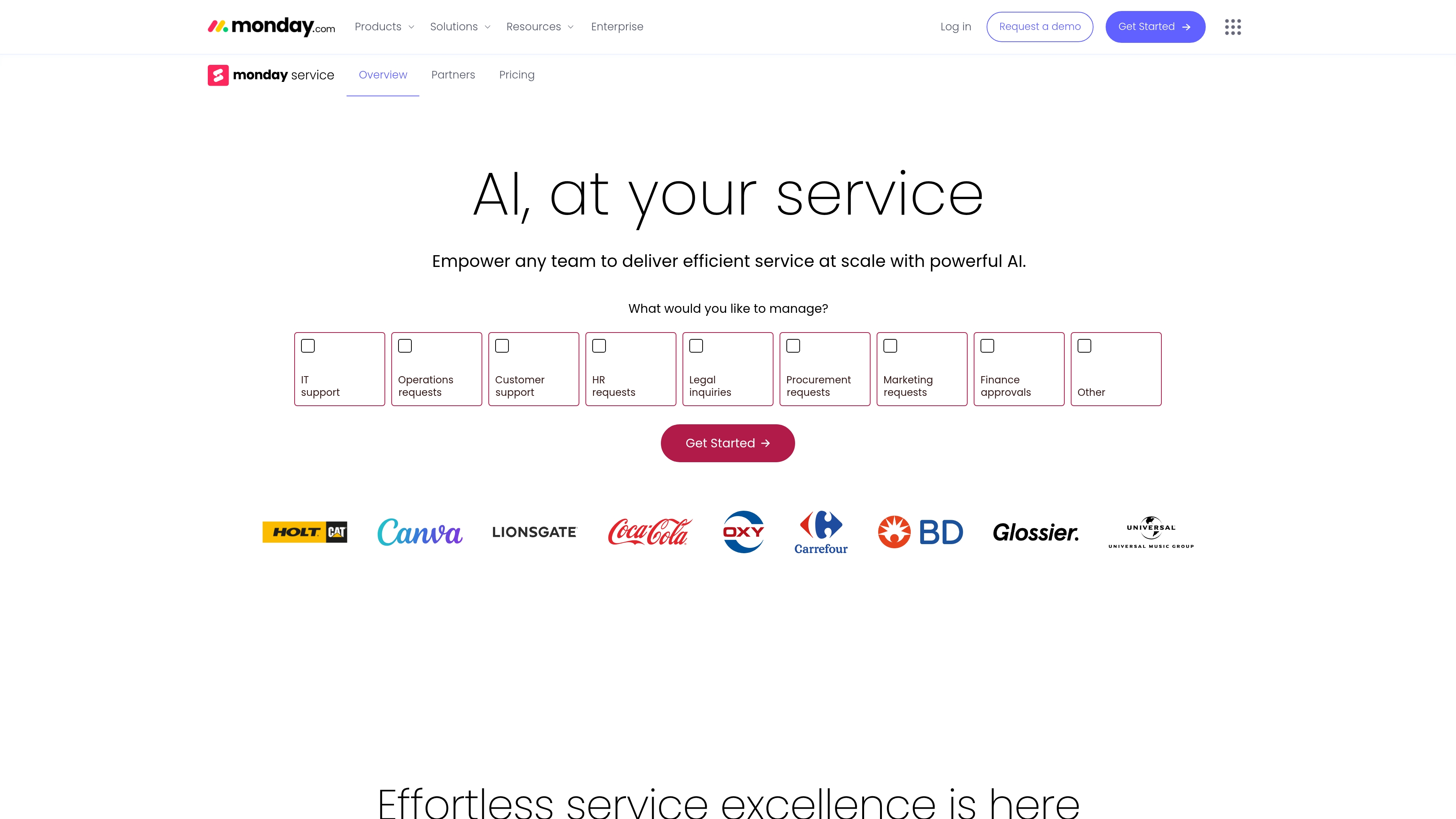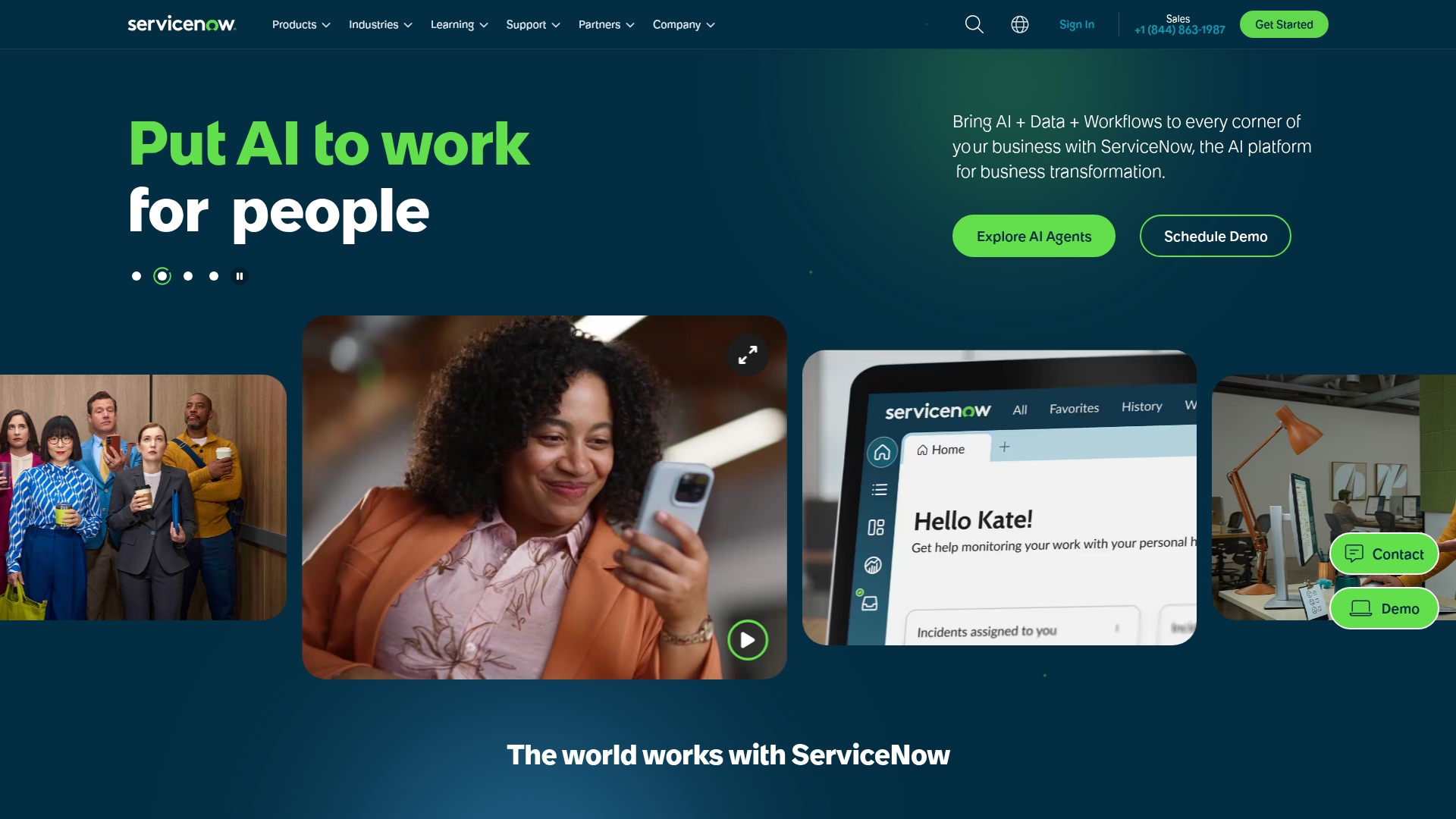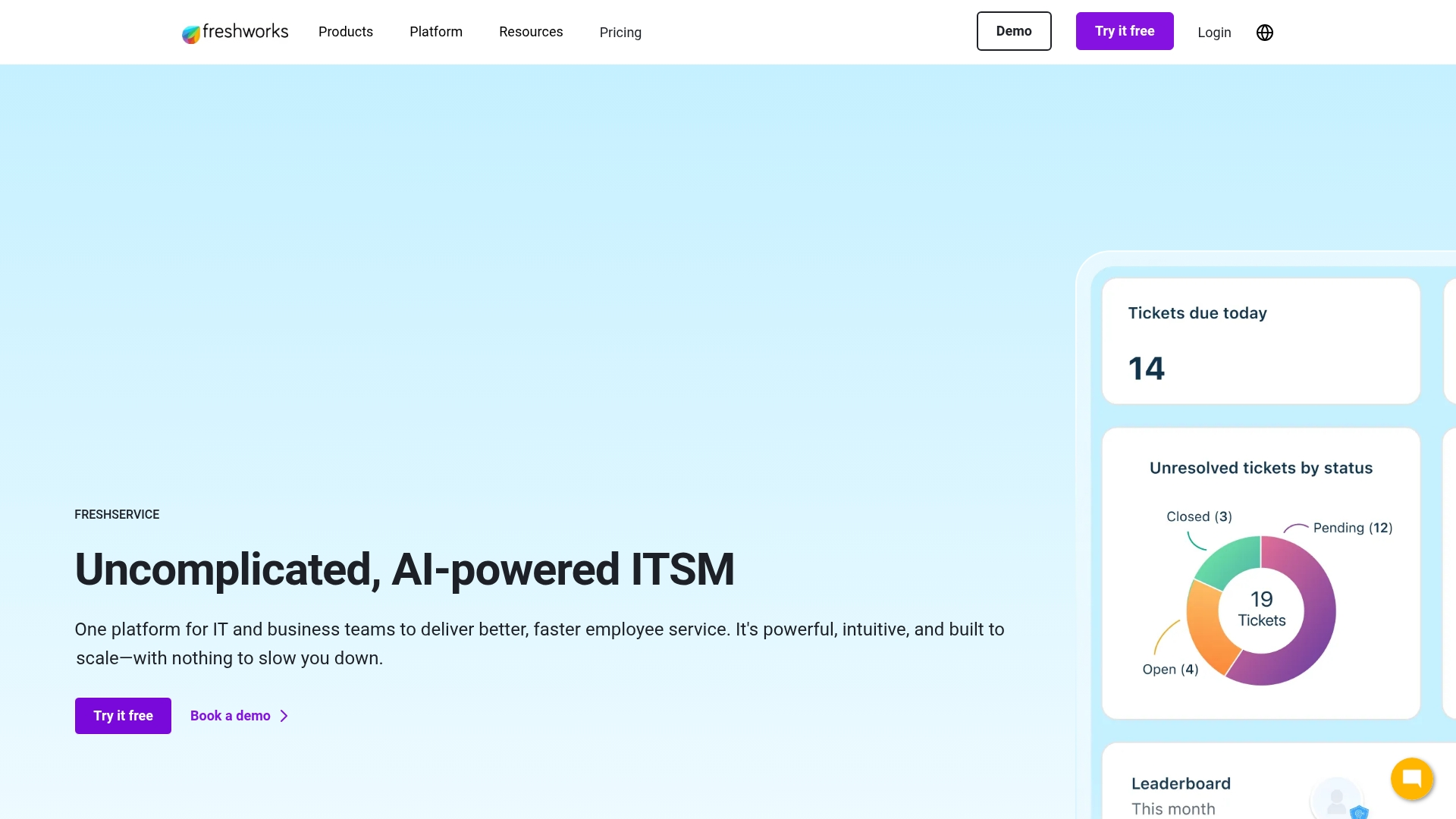Most teams don’t lose track of their technology all at once. It happens slowly, one unreturned laptop and one forgotten software subscription at a time. This quiet disorganization creates friction that slows down service teams and leads to unnecessary spending. Effective IT asset management software turns this inventory chaos into operational clarity, connecting what you own directly to how you support your team.
This is the core idea behind a unified service platform, where asset visibility empowers faster, smarter service delivery. This guide walks through the essentials of ITAM, from the core features you need to a five-step plan for successful implementation, helping you choose the right solution and build a system that works for your entire organization.
Try monday serviceKey takeaways
- ITAM centralizes devices, licenses, and subscriptions so teams resolve issues faster and reduce waste.
- The best platforms connect asset data to your service workflows for faster, context-rich resolutions.
- monday service ties ticketing, projects, and cross-department collaboration together so agents work with full context.
- Look for AI-assisted classification, SLA tracking, CSAT, and real-time analytics to move from reactive to proactive service.
What is IT asset management software?
IT asset management (ITAM) gives teams a complete, accurate view of every device, license, and subscription in one place. It serves as a single source of truth for your technology, showing what you own, where it is, and how it’s being used. With this visibility, teams make faster decisions and maintain control over the tools that keep operations running.
An ITAM system goes beyond inventory tracking. It discovers new assets automatically, identifies unused software, and highlights contracts that need attention. Instead of scattered data, you get actionable insights that help your organization stay lean, compliant, and ready for change.
When ITAM connects with your service platform, like monday service, it creates a full context around every request. Service teams see the history, status, and ownership of assets in real time, so they can act quickly and deliver stronger results across departments.
Why your organization needs ITAM software
Tracking technology with spreadsheets or disconnected tools leaves gaps that slow teams down and lead to waste. ITAM software consolidates every asset into one view, making it easier to manage hardware, software, and cloud resources across your organization.
This clarity supports better financial planning, keeps audits under control, and reveals opportunities to reduce spending on unused licenses. Instead of chasing data, leaders can make informed decisions about where to invest and how to improve performance.
For service teams, ITAM brings context to every interaction. When they can see which assets are involved, who owns them, and their current status, issues are resolved faster and with fewer touchpoints. The result is a more connected, responsive operation that builds trust across the organization.
Core features to look for in IT asset management platforms
The right IT asset management platform does more than track devices—it helps teams work smarter. The goal is to create a single source of truth that centralizes every asset, connects teams, and drives better decisions across the organization.
Automated asset discovery
A strong platform automatically identifies every device and software license across your network, eliminating manual tracking and incomplete spreadsheets. This automation builds real-time visibility into your environment and keeps asset data accurate as teams scale.
Lifecycle management
Comprehensive lifecycle tracking follows each asset from purchase to retirement. With monday service, teams can automate every stage of the asset lifecycle — procurement, deployment, maintenance, and replacement — so resources stay aligned with business priorities and budgets stay under control.
Connected service operations
Integrating asset data with service management brings full context to every ticket and request. When an incident arises, agents can view the related asset’s history and details instantly, reducing back-and-forth communication and resolving issues faster.
AI-powered insights
AI and real-time analytics uncover trends, predict hardware needs, and identify underused resources before they impact performance. monday service applies these insights to help teams plan ahead and optimize both costs and productivity.
Scalability and flexibility
A modern ITAM platform should adapt to how your organization works. With monday service, no-code customization lets teams configure workflows, dashboards, and automations to match evolving processes—without relying on developers or outside help.
Try monday serviceHow IT asset management software operates in practice
An IT asset management platform brings structure and visibility to your entire technology landscape. It organizes every device, license, and application into one clear view, giving teams the context to make faster, more informed decisions.
Implementation starts with automated discovery. The platform identifies each asset on your network and builds a complete inventory. From there, it tracks usage, performance, and maintenance in real time, so data stays accurate and actionable.
Dashboards visualize the details that matter most — cost, capacity, and performance — helping teams plan budgets, identify gaps, and anticipate needs. With monday service, AI and real-time analytics add another layer of insight, turning raw asset data into a connected operational workflow that keeps work moving.
How to choose the right ITAM solution for your team
The right ITAM platform should fit naturally into how your team already works. It should simplify asset tracking, automate repetitive steps, and scale with your organization’s needs. Look for flexibility — an interface your team will actually enjoy using and features that make daily operations easier.
Strong ITAM solutions bring together usability and depth. They integrate with existing systems to maintain a single source of truth across departments. The best platforms evolve with you, supporting growth without adding complexity.
Here, monday service stands out for its balance of power and simplicity. Teams can manage assets, service requests, and projects in one place while AI speeds up resolutions and analytics surface real-time performance data. The result is a unified workspace that helps IT teams stay proactive and ready for what’s next.
Best IT asset management software platforms
The ITAM market is full of capable tools, but the best choice depends on how your team works and what level of visibility you need. The most valuable platform is the one that integrates cleanly into daily operations, scales easily, and helps your team deliver faster, more accurate service.
Modern ITAM platforms go beyond hardware and software tracking. They connect asset data with service management to provide context for every request and decision. This link between assets and operations gives organizations the insight to act quickly and manage resources with confidence.
That’s the approach behind monday service. It connects asset management, ticketing, and projects in one collaborative space. When every asset and request live in the same system, teams move faster, communicate clearly, and deliver consistent, high-quality service across the organization.
monday service
monday service connects IT teams, assets, and service operations on one intuitive platform. It combines ticketing, projects, and automation to simplify how organizations manage requests, track assets, and collaborate across departments. Built for enterprise service management, it supports rapid implementation, no-code customization, and scalable AI-powered workflows that adapt to evolving business needs.

Use case: monday service enables IT teams to manage the full asset lifecycle — from procurement to retirement — while coordinating incident response, approvals, and cross-department collaboration in one connected workspace.
Best for: Enterprises and mid-sized organizations that need unified service and asset management, with AI automation and flexible customization built into their workflows.
Key features:
- Ticket management: Track, assign, and resolve service requests with full visibility into context and status.
- SLA configurations: Set clear response targets and automate alerts to keep service delivery on track.
- Service analytics: Monitor workloads, performance, and trends with real-time dashboards.
- CSAT surveys: Collect feedback directly after resolution to measure satisfaction and identify improvement areas.
- Multi-channel support: Consolidate email, chat, and form submissions into a unified service queue.
- AI copilot: Classify tickets, summarize updates, and suggest next steps using contextual insights.
- Automated workflows: Build no-code automations for routing, escalations, and approvals to reduce manual work.
- Knowledge management: Centralize documentation, FAQs, and standard operating procedures for quick reference.
- Service catalog: Offer pre-defined IT and operations services to standardize requests across departments.
Pricing:
Pricing plans start at $26/seat/month, with advanced capabilities available in Pro and Enterprise tiers.
Why it stands out:
- Centralizes IT asset, request, and project management on a single, visual platform.
- Enables no-code configuration so IT teams can adapt workflows without engineering support.
- Scales with automation and AI to meet the volume and complexity of enterprise operations.
- Provides visibility into every ticket and asset across departments for faster resolutions.
Advanced AI features:
- Automated ticket classification: Detects issue type, urgency, and sentiment for accurate prioritization.
- Smart routing: Assigns requests to the right agent or team based on expertise and workload data.
- AI-driven insights: Identifies recurring issues, highlights performance gaps, and recommends next actions.
- Knowledge suggestions: Surfaces relevant documentation and guides directly in active tickets to speed resolution.
Automations:
- No-code builder: Automate routine service and ITAM workflows for routing, approvals, and updates.
- Pre-built recipes: Deploy automation templates for common IT scenarios like onboarding or asset replacement.
- Scalable execution: Handle up to 250,000 automation actions monthly for large enterprise operations.
- Cross-department triggers: Connect automations between IT, HR, and finance for unified service management.
Integrations:
- Native connections: Integrates with Outlook, Gmail, Slack, Azure DevOps, and DocuSign for end-to-end workflow visibility.
- Open API: Enables secure data synchronization and custom connections with enterprise systems.
- Asset visibility: Consolidates data from CRM, directory, and asset tools for a complete operational view.
IT asset management software features:
- Asset lifecycle tracking: Monitor every asset from purchase through maintenance and retirement.
- QR code and mobile scanning: Update asset status from anywhere to maintain real-time accuracy.
- Performance dashboards: Analyze utilization, depreciation, and maintenance costs in one view.
- AI insights: Predict hardware replacement cycles and uncover optimization opportunities across departments.
ServiceNow
ServiceNow IT Asset Management (ITAM) gives enterprises a centralized view of their entire technology portfolio. Built on the Now Platform, it connects asset tracking with service workflows to improve visibility, control, and decision-making across complex environments.

Use case: Enterprises use ServiceNow ITAM to automate hardware, software, and cloud asset management at scale, ensuring accurate data across service and finance systems.
Key features:
- Unified asset lifecycle automation: Manage every asset from procurement to retirement with automated workflows.
- Enterprise-scale discovery and CMDB: Map asset relationships and maintain real-time data accuracy across IT infrastructure.
- AI-driven insights and dashboards: Track cost, utilization, and risk through customizable executive dashboards.
Pricing:
ServiceNow provides tailored quotes based on detailed evaluation of company needs and requirements.
Considerations:
- ServiceNow’s enterprise-grade depth can introduce complexity and require significant time and resources for setup and maintenance.
- Smaller organizations may find the investment high relative to their needs.
Freshservice
Freshservice by Freshworks offers a unified IT service and asset management solution for modern, mid-sized organizations. Its clean interface and fast deployment make it a popular choice for teams seeking agility without heavy configuration.

Use case: IT teams adopt Freshservice to manage service requests and assets together, streamlining incident resolution and lifecycle management through an easy-to-use cloud platform.
Key features:
- Automated asset discovery: Detect and catalog hardware and software across networks automatically.
- Lifecycle tracking: Monitor each asset from purchase to disposal with workflow visibility.
- Integrated CMDB: Map dependencies and configurations to understand how assets interact.
- AI support tools: Use automation and AI suggestions to reduce ticket resolution time.
Pricing:
Plans start at approximately $19 per agent/month, with tiered options including Growth, Pro, and Enterprise plans.
Considerations:
- Customization depth and advanced reporting are limited compared to enterprise tools.
- Performance can slow with large data sets, and mobile functionality trails the desktop experience.
ManageEngine AssetExplorer
ManageEngine AssetExplorer is a full-featured IT asset management platform designed to give IT departments control over hardware, software, and license compliance from a single console. It supports both agent-based and agentless discovery for flexible deployment.
 Use case: IT administrators use AssetExplorer to track and audit all company assets, maintain compliance, and create visual workflows that align with internal policies.
Use case: IT administrators use AssetExplorer to track and audit all company assets, maintain compliance, and create visual workflows that align with internal policies.
Key features:
- Comprehensive asset discovery: Identify and track assets with barcode, QR code, and RFID support.
- License and compliance management: Monitor usage and automate allocation to avoid over-licensing.
- Workflow designer: Build and customize asset lifecycle processes through a drag-and-drop interface.
- Reporting suite: Generate detailed cost, usage, and performance reports for audits and budgeting.
Pricing:
ManageEngine provides tailored quotes based on organization size and asset volume. A free edition supports up to 25 nodes, and a 30-day trial offers full access.
Considerations:
- The interface can feel dense for new users, and the mobile version offers limited functionality for field operations.
- Larger deployments may require additional configuration support.
Asset Panda
Asset Panda is a flexible, cloud-based IT asset tracking platform designed for organizations seeking scalability and simplicity without developer resources. Its mobile-first design and unlimited user model make it accessible across departments.
 Use case: Organizations use Asset Panda to move away from spreadsheets and unify asset tracking, maintenance, and audit processes in a customizable cloud platform.
Use case: Organizations use Asset Panda to move away from spreadsheets and unify asset tracking, maintenance, and audit processes in a customizable cloud platform.
Key features:
- Unlimited user licensing: Promote adoption across departments with no per-user limits.
- Mobile-first design: Manage assets anywhere with barcode scanning, GPS tagging, and offline mode.
- Customizable workflows: Adapt fields, forms, and permissions to fit existing processes.
- AI-powered automation: Use Ursa AI to automate imports, data mapping, and translations.
Pricing:
Custom quotes are available for the core platform, with a $10 per user/month option for basic collaborator seats.
Considerations:
- Setup and configuration can take time due to the high level of customization available.
- Pricing transparency is limited, requiring direct engagement with sales for quotes.
5 steps to implement IT asset management software successfully
Implementing IT asset management software requires a clear plan that aligns people, processes, and technology. These 5 steps outline how to launch your system smoothly and build lasting adoption across your organization.
Step 1: Audit your current assets
Start with a complete inventory of every device, license, and application. Use automated discovery tools to capture assets across your network, then fill in any gaps with a manual review. This gives you a baseline to measure progress and identify untracked tools or outdated resources.
Step 2: Define clear processes and workflows
Map each asset’s journey, from request to retirement. Create clear workflows that show ownership, responsibilities, and approval paths. When every step is simple and transparent, your team can move faster and stay aligned across departments.
Step 3: Plan your integration strategy
Connect your ITAM platform with the tools your teams already use—like HR, finance, and procurement systems. Automate data sharing between them to keep information consistent and up to date. A unified view eliminates silos and helps every department work from the same data.
Step 4: Train your team
Hold hands-on training sessions focused on real scenarios your team faces each day. Show how the system simplifies work and saves time instead of focusing on features. When people see immediate value, adoption happens naturally.
Step 5: Monitor and optimize
Track how teams use the platform and where bottlenecks appear. Use built-in analytics to spot trends, gather feedback, and make small adjustments over time. Regular reviews help you strengthen processes and maintain long-term impact.
Streamline IT asset management with monday service
Managing IT assets shouldn’t slow your team down. monday service brings asset tracking, service requests, and team collaboration into one connected workspace that’s easy to use and quick to scale.
When an asset issue occurs, automations trigger the right workflows and alert the right people instantly. Built-in AI categorizes requests, routes them to the right teams, and removes repetitive steps so IT can focus on strategic work.
This visibility extends across departments, keeping IT, finance, and procurement aligned around a single source of truth. Instead of digging through spreadsheets or chasing updates, teams get real-time insight that drives faster decisions and smoother operations. monday service turns complex asset management into a connected, collaborative system that keeps everything, and everyone, moving forward.
Try monday serviceFAQs
What is the difference between ITAM and ITSM software?
ITAM focuses on managing your technology assets’ lifecycle, while ITSM handles IT service delivery and support processes. Integrating them gives your team the complete context needed to resolve issues much faster.
How much does IT asset management software typically cost?
Costs vary based on the number of assets and features you need, with many plans using a per-asset-per-month model. Most platforms also offer custom pricing for larger organizations with more complex needs.
Can ITAM software manage both hardware and software assets?
Absolutely. Modern ITAM platforms manage both hardware, like laptops and servers, and software assets, like licenses and cloud subscriptions. This provides a single, unified view of your entire technology ecosystem.
How long does it take to implement IT asset management software?
Implementation can take anywhere from a few weeks to several months, depending on your organization’s size and complexity. Cloud-based platforms are typically much faster to deploy, getting your team up and running quickly.
What size company needs IT asset management software?
Any organization struggling to track its technology can benefit, but it becomes essential for teams with over 50 assets or complex compliance needs. It's especially crucial for rapidly growing or remote-first companies.
How does ITAM software help with software license compliance?
It automatically tracks software installations and usage against your purchased licenses to identify any compliance gaps. The system generates reports and sends alerts for renewals, helping you avoid expensive audit penalties.
 Get started
Get started 

